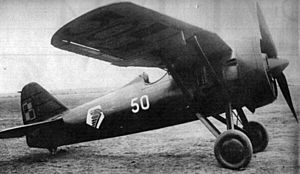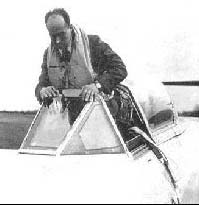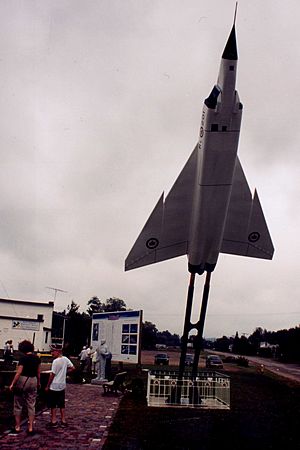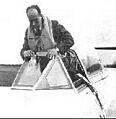Janusz Żurakowski facts for kids
Quick facts for kids
Janusz Żurakowski
|
|
|---|---|

Żurakowski c. 2003
|
|
| Born | 12 September 1914 Ryżawka, Russian Empire
|
| Died | 9 February 2004 (aged 89) Barry's Bay, Ontario
|
| Occupation | Aviator Lodge owner |
| Spouse(s) | Anna Żurakowska |
| Children | George Żurakowski and Mark Żurakowski |
| Parent(s) | Adam Żurakowski and Maria Antonina Szawłowska |
| Relatives | Bronisław and Adam Żurakowski (Brothers) |
| Awards | |
Janusz Żurakowski (born September 12, 1914 – died February 9, 2004) was a brave Polish fighter and test pilot. He lived and worked in Poland, the United Kingdom, and Canada during his life. He was known for his amazing flying skills and for testing some of the most advanced airplanes.
Becoming a Pilot
Żurakowski was born in 1914 in a village called Ryżawka. This village was in the Russian Empire at the time. After a war, his family had to leave their home. They moved to the new country of Poland for safety.
Janusz went to high school in Lublin, Poland. There, he learned to fly gliders, which are planes without engines. In 1934, he joined the Polish Air Force. He went to the Air Force Officers' School. After learning to fly powered airplanes, he became a sub-lieutenant in 1935. He then became a fighter pilot and later a flying instructor.
World War II Hero
In September 1939, World War II began. Żurakowski had his first combat flight. He flew an older PZL P.7 trainer plane. He faced seven German Dornier 17 bombers. He managed to damage one of them before his guns stopped working.
After Poland was defeated, Żurakowski escaped to England. Many Polish pilots went to France first. They fought against German planes in the Battle of France. Janusz was supposed to train as a bomber pilot in England. But the Royal Air Force (RAF) changed its mind. They sent him to fighter squadrons instead. These squadrons were getting ready to defend Britain.
Fighting in the Battle of Britain
Żurakowski joined No. 234 Squadron. He flew the famous Supermarine Spitfire Mk. 1. He fought against the German Luftwaffe. On August 15, 1940, he shot down a German Messerschmitt Bf 110. This was during the important Battle of Britain.
He was shot down nine days later but quickly returned to duty. He then shot down two more German planes. As the Battle of Britain ended, he damaged another German plane. He later became a flight instructor. He taught new fighter pilots how to fly in combat.
In 1942, Żurakowski flew with other Polish pilots. He became a squadron leader for No. 316 Polish Fighter Squadron. He often flew alongside USAAF bombers. He protected them during daylight bombing raids. In 1943, he was given the Virtuti Militari award. This is Poland's highest military honor. He also received the Polish Cross of Valour twice.
Life After the War
After the war, Żurakowski decided to stay in Britain. In 1944, he went to the Empire Test Pilots' School. He became a highly skilled test pilot. From 1945 to 1947, he tested many different planes. He worked for the Aeroplane and Armament Experimental Establishment. He tested naval aircraft for the Air Ministry. He even learned to land a Supermarine Seafire (a naval Spitfire) on an aircraft carrier.
While working as a test pilot, Żurakowski flew over 30 types of aircraft. These included the Vampire and the Gloster Meteor. He was known for his amazing aerobatic displays. He would perform incredible stunts in the air. At the 1946 Farnborough Airshow, he gave a spectacular show. He flew the Martin-Baker MB 5 fighter plane.
In 1947, he left the RAF. He became the chief experimental test pilot for Gloster Aircraft Company. He tested many new versions of Gloster planes. These included the Gloster Meteor and Javelin. In 1950, he set an international speed record. He flew a Gloster Meteor from London to Copenhagen and back. This helped Gloster sell planes to the Danish Air Force.
The "Zurabatic Cartwheel"
At the 1951 Farnborough Airshow, Żurakowski showed a brand new aerobatic move. He called it the "Zurabatic cartwheel." He made the Gloster Meteor G-7-1 prototype spin vertically in the air. This was the first new aerobatic move in 20 years! It was a very difficult and risky maneuver. It showed his incredible skill as a pilot.
Moving to Canada
In 1952, Żurakowski and his family moved to Canada. He became a test pilot for A.V. Roe Canada. He focused on testing experimental planes. On December 18, 1952, he broke the sound barrier. He was the first pilot in Canada to do this. He flew the CF-100 fighter plane. This was the first straight-winged jet to break the sound barrier.
On August 23, 1954, Żurakowski survived an explosion. He was testing an experimental rocket pack. Sadly, his observer, John Hiebert, did not survive.
Żurakowski continued to perform amazing aerobatic displays in Canada. He was called the "Great Zura" by many. In 1958, he became the chief development test pilot for the new CF-105 Avro Arrow program. This was a very advanced fighter jet. On March 25, 1958, Żurakowski flew the first Avro Arrow. The flight lasted 35 minutes and went perfectly. He flew the Arrow on 21 test flights. He reached speeds of Mach 1.89 and altitudes of 50,000 feet.
After flying the Arrow on September 26, 1958, Żurakowski decided to stop test flying. He had promised his wife he would stop experimental flying after he turned 40. He had already passed that age.
Later Years
Żurakowski retired from flying in November 1958. He continued to work as an engineer for Avro Aircraft. On February 20, 1959, the Avro Arrow program was suddenly cancelled. This was a sad day for many people. The five flying Arrows and all the factory tools were destroyed. Only parts of the Arrows remain today. They are on display at the Canada Aviation Museum.
After leaving aviation, Żurakowski and his family moved to Barry's Bay, Ontario. They built and ran a small tourist lodge called Kartuzy Lodge for over 40 years. He also used his engineering skills to design and build sailboats and ice-boats.
Janusz Żurakowski passed away at Kartuzy Lodge on February 9, 2004.
Honors and Legacy
Janusz Żurakowski received many honors for his contributions to aviation.
- In 1973, he was inducted into Canada's Aviation Hall of Fame.
- In 1996, the Royal Canadian Mint released a special coin. It featured the Avro Canada CF-100 Canuck and Janusz Żurakowski.
- In 1997, he was honored by the Western Canada Aviation Museum.
- In 1999, a new facility at CFB Cold Lake (Alberta) was named the "Żurakowski Building."
- In 2000, he became an honorary member of the Society of Experimental Test Pilots. He joined famous pilots like Charles Lindbergh and Neil Armstrong.
- He received the Commander's Cross of the Order of Merit of the Republic of Poland in 1999.
His adopted hometown built Żurakowski Park in 2003. It has two large statues of Janusz Żurakowski and his beloved Avro Arrow. The park is shaped like an arrow. There is also a "Zura Avenue" in Gloucester, UK, where the Gloster Aircraft company used to be.
Images for kids












